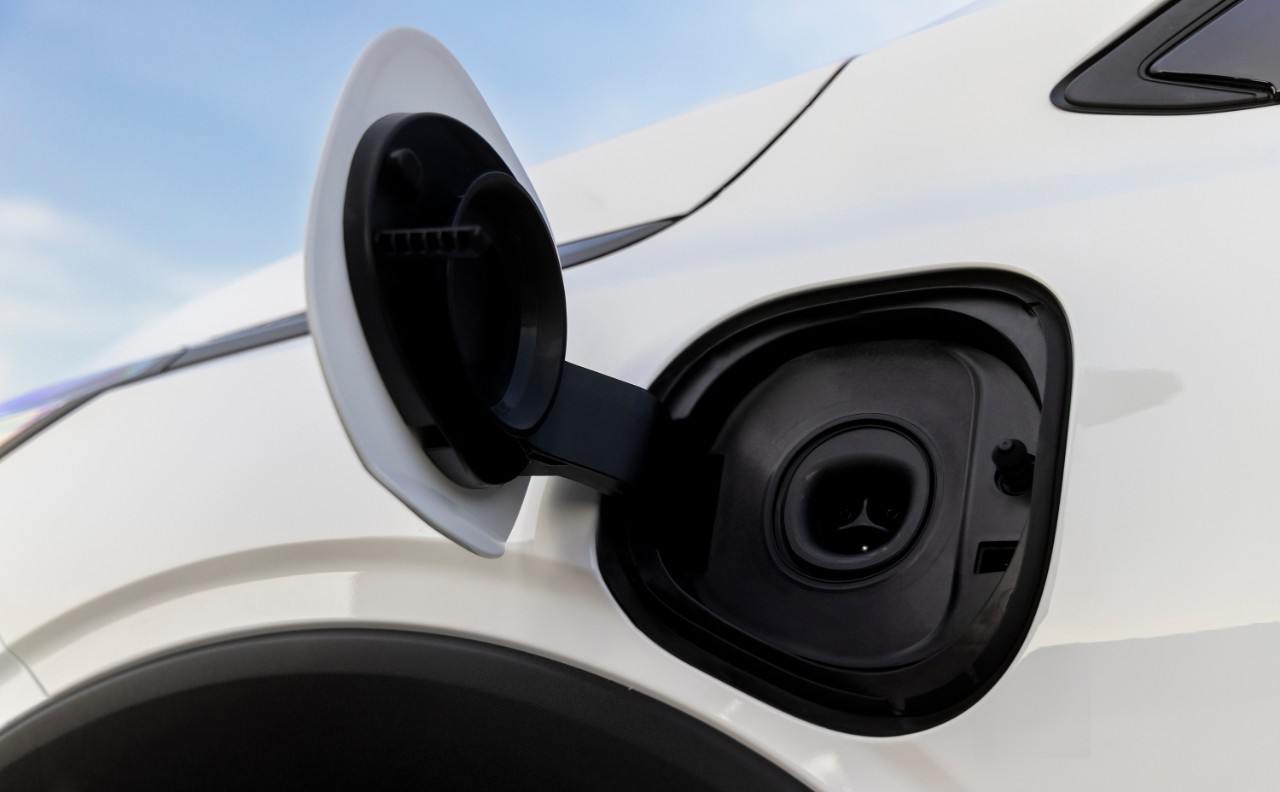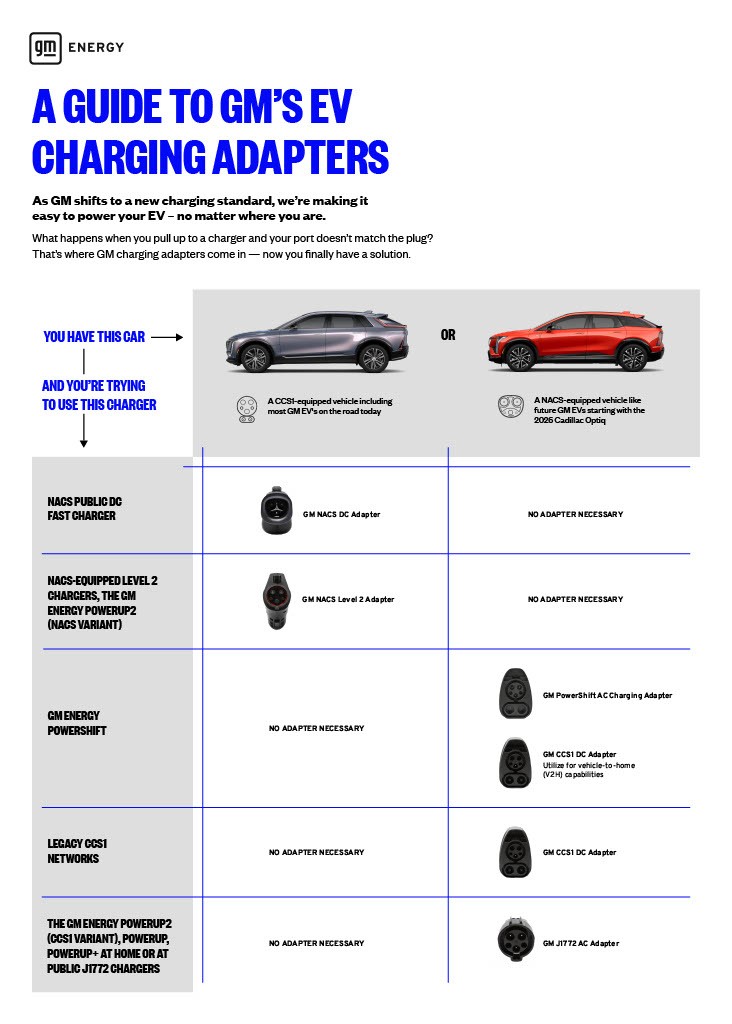EV adapters 101: Powering GM’s path to charging standardization
2025-08-28
On General Motors’ path to an all-electric future, we’re helping to unify how you power your journey by working across the industry to standardize charging plugs. To help customers navigate this shift, there’s an important and convenient tool: the EV charging adapter.
Why adapters matter now
The EV landscape is evolving. GM EVs now on the road are equipped with CCS1 (Combined Charging System 1) charging ports. But this year, we’re starting a transition to a native NACS (North American Charging Standard) port for GM vehicles to help enable a future where a single charging station plug shape is necessary for charging. Starting with the 2026 Cadillac OPTIQ and OPTIQ-V, GM EVs will begin transitioning to the NACS standard.
That creates a little complication: there will be cars on the road with both standards, as well as chargers of both varieties in public and private settings. Until the transition is complete, GM’s suite of adapters will provide a convenient, flexible way to connect your GM vehicle to a charging station, whether at home or on the road. No matter which vehicle you have, GM EV owners will have access to a network of more than 250,000 chargers across North America.
A brief history of standardization
Think of this shift in EV charging standards like the USB-C evolution in smartphones and laptops. For years, technology companies used competing ports, until the industry gradually aligned around one simple standard. The same thing happened with the HDMI standard for TVs and computer displays.
We're seeing a similar moment now with EV charging. As automakers and charging networks coalesce around the NACS standard, the industry is rallying to provide a more seamless and consistent experience for drivers. It’s a big win for consumers, who will benefit from broader access and greater convenience.
GM’s new adapters help ensure that every customer can navigate this transition with confidence, no matter what vehicle they drive today or where they charge tomorrow.
Sometimes you need them, sometimes you don’t
In many cases, EV drivers will be able to plug-and-charge without needing an adapter. For instance, if you own a NACS-equipped 2026 Cadillac OPTIQ and are using a GM PowerUp 2 NACS home charger, you can just plug in, no adapter required. However, if you need a charger that doesn’t match your vehicle’s charging inlet, an appropriate adapter can help you make the connection to a charging station.
Choosing the right adapter
Here’s a simple breakdown of our adapters, which will be available through the myChevrolet, myGMC, and myCadillac apps, our brand accessories websites, or through your local dealership:
Insert Infographic HERE
Using an adapter is simple
Choose the correct adapter for your vehicle’s port and the charger’s plug type.
Connect the adapter to the charger first, then plug the other end into your vehicle.
Wait for the indicator ring to flash blue (recognizing) and then turn green (charging).
Monitor the session via your GM vehicle brand app and go about your day.
GM’s EV adapters are built to rigorous safety and reliability standards and integrate features like Plug-and-Charge (available through the GM vehicle mobile apps), which automatically authenticates and pays for your session when charging at stations where this capability exists.
Learn more:
Visit our EV Charging 101 Guide for charging best practices and how-to’s.
Order your adapter through your GM vehicle brand app or our accessories websites or visit a local dealer.
Talk to a GM Energy Home Energy Consultant to explore home setup options, including the GM Energy PowerShift Charger.
Visit the GM Energy website for the latest in-home energy and public charging information.
The 2027 Chevrolet Bolt will have a NACS charging port.
On General Motors’ path to an all-electric future, we’re helping to unify how you power your journey by working across the industry to standardize charging plugs. To help customers navigate this shift, there’s an important and convenient tool: the EV charging adapter.
Why adapters matter now
The EV landscape is evolving. GM EVs now on the road are equipped with CCS1 (Combined Charging System 1) charging ports. But this year, we’re starting a transition to a native NACS (North American Charging Standard) port for GM vehicles to help enable a future where a single charging station plug shape is necessary for charging. Starting with the 2026 Cadillac OPTIQ and OPTIQ-V, GM EVs will begin transitioning to the NACS standard.
That creates a little complication: there will be cars on the road with both standards, as well as chargers of both varieties in public and private settings. Until the transition is complete, GM’s suite of adapters will provide a convenient, flexible way to connect your GM vehicle to a charging station, whether at home or on the road. No matter which vehicle you have, GM EV owners will have access to a network of more than 250,000 chargers across North America.
A brief history of standardization
Think of this shift in EV charging standards like the USB-C evolution in smartphones and laptops. For years, technology companies used competing ports, until the industry gradually aligned around one simple standard. The same thing happened with the HDMI standard for TVs and computer displays.
We're seeing a similar moment now with EV charging. As automakers and charging networks coalesce around the NACS standard, the industry is rallying to provide a more seamless and consistent experience for drivers. It’s a big win for consumers, who will benefit from broader access and greater convenience.
GM’s new adapters help ensure that every customer can navigate this transition with confidence, no matter what vehicle they drive today or where they charge tomorrow.
Sometimes you need them, sometimes you don’t
In many cases, EV drivers will be able to plug-and-charge without needing an adapter. For instance, if you own a NACS-equipped 2026 Cadillac OPTIQ and are using a GM PowerUp 2 NACS home charger, you can just plug in, no adapter required. However, if you need a charger that doesn’t match your vehicle’s charging inlet, an appropriate adapter can help you make the connection to a charging station.
Choosing the right adapter
Here’s a simple breakdown of our adapters, which will be available through the myChevrolet, myGMC, and myCadillac apps, our brand accessories websites, or through your local dealership:
Using an adapter is simple
- Choose the correct adapter for your vehicle’s port and the charger’s plug type.
- Connect the adapter to the charger first, then plug the other end into your vehicle.
- Wait for the indicator ring to flash blue (recognizing) and then turn green (charging).
- Monitor the session via your GM vehicle brand app and go about your day.
GM’s EV adapters are built to rigorous safety and reliability standards and integrate features like Plug-and-Charge (available through the GM vehicle mobile apps), which automatically authenticates and pays for your session when charging at stations where this capability exists.
Learn more:
- Visit our EV Charging 101 Guide for charging best practices and how-to’s.
- Order your adapter through your GM vehicle brand app or our accessories websites or visit a local dealer.
- Talk to a GM Energy Home Energy Consultant to explore home setup options, including the GM Energy PowerShift Charger.
- Visit the GM Energy website for the latest in-home energy and public charging information.

